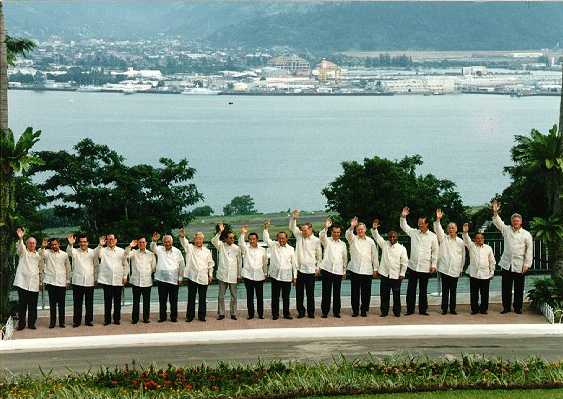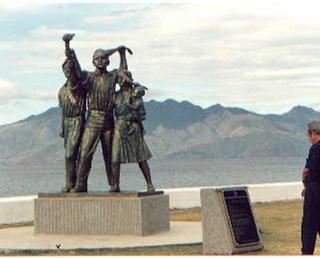mega manila and subic
monument to subic volunteers
“What is this Mega Manila? This is really the Subic-Clark area. This is intended to serve as part of the expansion of Metro Manila -- which is congested -- and they become one economy. So this becomes the interface between North Philippines and Metro Manila.” -PGMA (at the 2005 Trade Investment Progress and Tourism conference)
Subic and Clark are clearly going to be growth areas. Apart from the 94-kilometer Subic Clark Expressway Toll Project (SCTEP), the government is also investing in the Metro Clark Rapid Railway System (Northrail) and transferring the DOTC to Clark.
Subic captured the nation's imagination when it was protected from looting by volunteers after the dismantling of the US Naval Base. The volunteers were led by (then Olongapo Mayor) Senator Richard Gordon. Subic's highpoint was the 1996 APEC convention.
 but then it went downhill in 2000 with the Estrada-Payumo vs. Gordon standoff.
but then it went downhill in 2000 with the Estrada-Payumo vs. Gordon standoff.Tumultuous politics aside, my main concern is that ever since its turnover, Subic's development initiatives have all been anchored on tourism and low-tariff industrial zones. All the old base residential facilities were turned into hotels or vacation homes. Land was set aside as industrial parks as part of the Subic Bay Special Economic Zone. Apart from the factrories and Fedex, commerce was anchored on duty-free style warehouse stores. The biggest investment (of dubious success) was the Subic Bay Yacht Club. --There was no plan for workforce housing nor a cohesive development plan for the surrounding municipalities.
Fifteen years, and three administrations later, Subic has yet to deliver fully on the promise.
There is a new, very competent team on board led by Keiko Licuanan (ex-president of Ayala Land) and Patrick Gregorio (ex-president of Waterfront Hotels). Licuanan is credited with the success of Makati (built on McMicking's vision) and Gregorio is well known among tourism circles.
As accomplished as they are, the appoinment of Licuanan and his selection of Gregorio point to the priorities of the government in SBMA/SCAD and the kind of questions they are asking: i.e. "How do we make this a commercial success?" and "How do we make this a successful tourist spot?"
Given the size of the region, I think they have to start thinking beyond investment zones and tourist centers. I think the better questions should be:
- What kind of city are we building?
- Who will live here? Where will they live?
- What will they do/ Where will they work?
- How will people travel to get to where they work?
- Where will people go to buy their daily needs?
- What kind of place will this be?
Subic and the Subic-Clark corridor, if it hopes to decongest Metro Manila, must transcend the pressure to make money and begin to think itself as a real metropolis. Begin to envision how it will grow as a city. (Perhaps they are already thinking of this and asking the same questions, but have not given these play in the media.)
Cities are not built by tourists or by factories, they are built by residents. And the most successful cities in the world today -cities that bring in tourists and investors -are genuine places with full-time residents.
Subic will grow into a metropolis. The sooner it thinks itself as a metropolis (with the components of housing, retail, commerce and civic spaces), the better the vision it will create for itself. Otherwise, it will not solve the congestion problems of Metro Manila - it will only duplicate Metro Manila's congestion.


11 comments:
It seems that Ayala Land will develop a high-end seaside residential resort in the neighborhood of Subic (Anvaya Cove).
This might be a positive element.
Positive for whom? It can be a very successful residential resort in financial terms (i.e. -they sell all the units) but what will it do for full time subic region workers and residents? will it be just another enclave?
I doubt if any of the buyers will be staying in Anvaya full time.
Where will the people who will tend these houses and work in the resort live? How will they get to the resort?
How does this resort work in relation to the rest of the metropolitan region? Apart from taxes, how else will it contribute to the economy?
I'm not saying it's not good to have developers come in with high-end projects. I'd just like to see more middle class and affordable residential projects go up. Projects that are integrated into a rational plan, not just a series of gated villages served by cars.
Much as I would like to follow your frame of "Tumultuous politics aside", it cannot be excluded from the equation. How long will the current political crisis push back the infrastructure projects? Will the current SBMA/SCAD team even be around long enough to see half of these projects started?
And when all has finally been built, will investors come? A contiguous Indo-Sino Free Trade Zone is more attractive than an area you have to fly or sail to.
all the more reason why the development of the subic-clark corridor has to be planned now -beyond the infrastructure projects.
if they can assemble a regional plan that involves all the stakeholders - including all affected provinces and municipalities -then the plan can outlast the politics.
and a plan anchored simply on attracting investments falls precisely because you are competing against china and the rest of south east asia.
grow subic on the basis of the expansion of the metro region -create a fine grained economy where the corner stores is as important as the industrial park, then you are growing a city -not just an investment destination.
I still can't see what Subic's goals are. Its not clear if it will become a "premiere" tourist spot, an alternative metro manila, residential community with free housing or simply just wasting the country's resources.
If the SBMA thinks that Fedex's move to Guangzhou (http://news.inq7.net/breaking/index.php?index=2&story_id=44229) was "unfortunate" for us. I think its more than that. You have a world leading courier on their backyard leaving would somehow take some image that Subic is not big enough for foreign investors.
quoting from that inquirer article:
"a greater consideration was that the company's future growth in Asia lay in China"
that's undeniable. and I agree with Ian that Subic's goals don't seem to be very clear. Or at best, doesn't seem to be very differentiated from other ecozones and new cities that china, korea, india, malaysia and indonesia are building. (with more money and at a frantic pace.)
Instead of asking "how do we get big companies to invest here?" I think the better question for subic should be: "how do we get talent to locate and live here?"
I am not a shareholder of Ayala Land :-( but if I look at their past projects I have the impression they have the knowledge, the power and the financial means to develop a whole city (or at least parts of it).
Look at what they did in Ayala Alabang and what they do now in Fort Bonifacio.
Ok, Ayala Alabang is a gated community but look what happened around. Two big malls, hotels, the beginning of a cyber city, etc. This is giving work to a lot of people.
In Fort Bonifacio they attracted different schools, build a mall, St.Luke's started to build a new hospital. Countless projects are on the move.
If Ayala Land start a project in Subic I am sure the rest will follow.
I also get the impression that Ayala Land is shifting some of its attention to mid-end projects with it's sister company ALI.
I actually used to work with Ayala Corp and still hold them in high esteem. (I'm still in touch with the Old Man and consider him a good friend.)
Makati is a commercial success -but the lack of planning/policy for affordable housing (not totally Ayala's fault but local government's) has added to the spatial mismatch between jobs and housing. Fort is building on Makati's energy.
I have no doubt they are thinking of a 50 year horizon in Subic, but do we want another Alabang? High-end retail surrounded by gated communities where the only way to get around is by motorized vehicles?
..."work for"
not "work with"
Post a Comment